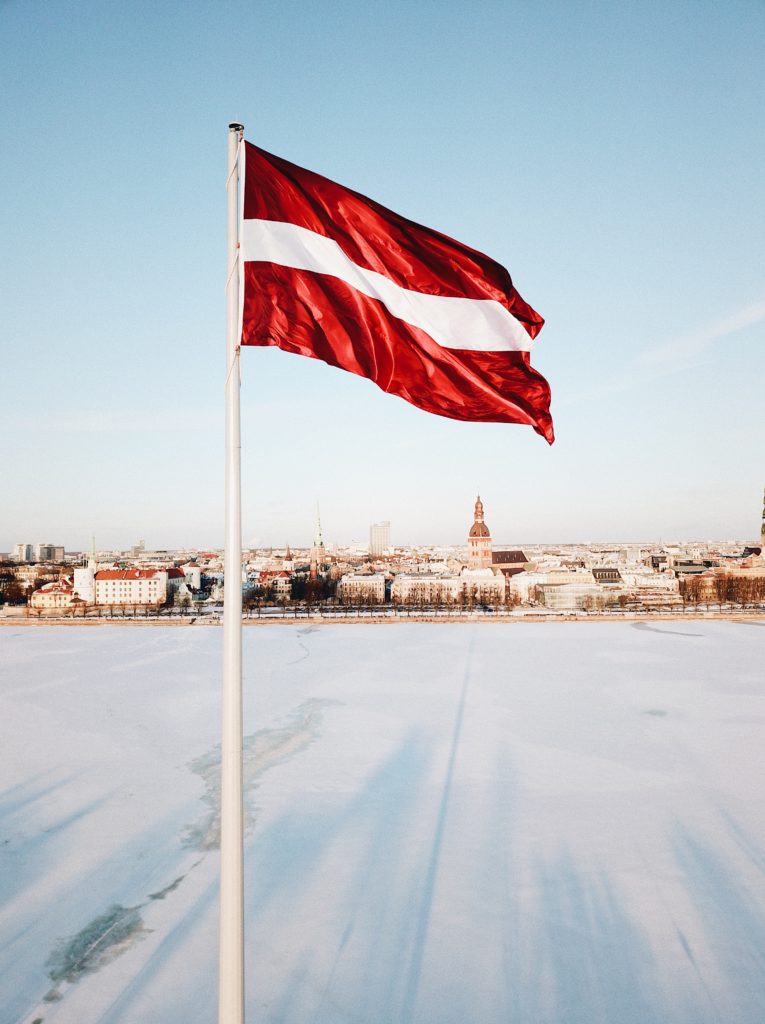About Latvia
Nestled in Northeastern Europe, the Republic of Latvia is a captivating blend of rich history, stunning natural beauty, and modern vitality. Founded on November 18, 1918, and reclaiming its independence on August 21, 1991, Latvia stands as a resilient nation with deep roots in its ancient Latgalian heritage. As one of the Baltic States, it boasts a landscape of sprawling forests, over 12,500 rivers, and a temperate climate shaped by the Baltic Sea. Today, with a population of approximately 1.86 million in 2025, Latvia thrives as a member of the European Union and NATO, using the euro since 2014. From its iconic maroon-and-white flag—one of the world’s oldest—to its vibrant Midsummer celebrations, Latvia offers a unique gateway to both tradition and opportunity in the heart of Europe.
History and independence
Latvia’s history includes its founding on November 18, 1918, recognized by several countries by 1920. It faced occupations by the Soviet Union (1940-1941), Nazi Germany (1941-1945), and again the Soviet Union (1945-1991) before restoring independence on August 21, 1991, and joining the United Nations on September 17, 1991. This restoration was a pivotal moment, reflecting Latvia’s resilience against foreign domination, with the name ‘Latvia’ derived from ancient Latgalians, one of four Indo-European tribes contributing to Latvian ethnogenesis.
Flag and cultural symbolism
The Latvian flag, with maroon and white stripes, is noted as one of the oldest, with historical references in the 13th-century Rhymed Chronicle of Livonia, describing its use in a battle around 1279. A popular legend attributes its design to a wounded leader’s blood staining a white sheet, used in a subsequent victorious battle, a story officially recognized under the Constitution of Latvia (Satversme). This symbol reflects national resilience and historical continuity.

Geographical and environmental profile
Latvia, covering 64,589 km², is centrally located among the Baltic States in Northeastern Europe, bordered by Estonia, Lithuania, Russia, and Belarus, with a maritime boundary with Sweden Geography of Latvia. Its terrain, shaped by the Ice Age, consists mainly of lowlands below 100 meters above sea level, with the highest point, Gaiziņkalns, at 311.6 m. The country boasts over 12,500 rivers and 2,256 lakes larger than 1 hectare, with forests covering 55% of the land, a significant increase from historical figures, ranking fifth in the EU Latvia Forest Coverage. This extensive forest coverage supports diverse wildlife, including black storks, lynxes, and wolves, making Latvia a sanctuary for biodiversity.
Climate and weather patterns
Latvia lies in a temperate climate zone, influenced by the Baltic Sea and Atlantic air masses, with four distinct seasons. Summer averages 19°C, while winter averages -6°C, with record temperatures of 37.8°C in Ventspils (August 4, 2014) and -43.2°C in Daugavpils (February 8, 1956) Latvia Climate Data. The climate experiences frequent rainfall, with about 180 rainy days annually, contributing to snowstorms in February, thunderstorms in July, and strong winds in October, reflecting its dynamic weather patterns.
Demographic trends and population dynamics
As of March 2025, Latvia’s population is estimated at 1,860,784, based on UN data, reflecting a continued decline due to emigration and low birth rates Latvia Population Data. Urban areas house about 68% of the population (approximately 1,265,333), with 32% (595,451) rural, consistent with recent trends showing 69.8% urban in 2023 Latvia Urban Population. The 2021 census showed ethnic Latvians at 62.7%, with Russians at 24.2%, Belarusians at 3.2%, Ukrainians at 2.2%, Poles at 2.0%, Lithuanians at 1.1%, and others at 4.6%, reflecting a diverse demographic influenced by historical migrations and Soviet policies Demographics of Latvia.
| Year | Total Population | Urban Population | Rural Population | Ethnic Latvians (%) |
|---|---|---|---|---|
| 2025 | 1,860,784 | 1,265,333 | 595,451 | 62.7 |
| 2021 | 1,893,223 | ~1,287,392 | ~605,831 | 62.7 |
Language education and religion
Latvian, a Baltic language, is the sole official language, with Russian and English common, while German and Scandinavian languages are less prevalent Demographics of Latvia. Education is free at the primary level, with numerous higher education programs, and foreign EU students pay domestic rates, reflecting Latvia’s commitment to accessibility. Religiously, Christianity covers 79% of the population, with Lutherans, Catholics, and Orthodox Christians dominating, though only 7% attend services regularly, indicating a secular trend.

Governmental structure and international engagement
Latvia operates as a parliamentary republic, with the Saeima, a 100-member parliament elected every four years under proportional representation, and a President with a ceremonial role, elected by the Parliament Latvia Government. The judicial system is three-tiered, including district, regional, and Supreme Courts, with a Constitutional Court. Latvia is active in international organizations, joining the EU and NATO in 2004, and is a member of the UN, WTO, and OSCE, enhancing its global presence Latvia International Organizations.
Economic landscape and trade relations
The economy features sectors like IT, chemicals, wood processing, and agriculture, with services contributing the largest GDP share. Latvia adopted the euro on January 1, 2014, replacing the Latvian lat, a significant shift from historical currency Latvia Euro Adoption. Main trade partners in 2024 included Lithuania (24.3% imports), Estonia (10%), and Germany (9.6%), with exports to Lithuania, Estonia, Germany, and Russia, reflecting strong EU ties and geopolitical influences Latvia Trade Partners.
Cultural highlights and traditions
Traditional foods include caraway cheese, grey peas with bacon, and rye bread, reflecting Latvia’s culinary heritage. The Midsummer celebration (Jāņi), held on June 23-24, involves bonfires, folk songs, and dancing, a pre-Christian tradition symbolizing community and nature, still vibrant today Latvia Culture.
This detailed analysis ensures a comprehensive understanding, highlighting updates and corrections for accuracy as of April 1, 2025.
Finance sector, currency, trade partners
Latvia’s financial sector is a robust pillar of its economy, overseen by the Bank of Latvia, a member of the European System of Central Banks. As of 2025, the sector is dominated by Scandinavian banks such as Swedbank and SEB, alongside locally rooted institutions like Luminor and Citadele, bolstered by American capital. There are no state-owned commercial banks, but the government supports development through Altum, a state-owned finance institution. The sector has seen significant reform, with foreign direct investment (FDI) stock rising to $26 billion in 2024, a 4.4% increase from 2023, driven by investments in banking, real estate, and technical services. In 2025, the Temporary Solidarity Contribution (TSC) tax, levied at 60% on banks’ surplus net interest income, is projected to raise $100 million, reflecting efforts to balance financial growth with fiscal responsibility. Latvia maintains an open financial system with no foreign exchange controls or restrictions on capital repatriation, fostering a competitive environment for investors.
Since January 1, 2014, Latvia’s official currency has been the euro (€, EUR), fully integrated into the Eurozone. This replaced the Latvian lat, which had been in use from 1993 until the transition. The euro’s adoption has strengthened Latvia’s economic ties within the European Union, facilitating seamless trade and investment. In 2025, the euro continues to underpin Latvia’s monetary stability, with inflation forecasted at 2.2% by the IMF, reflecting moderate price pressures amid global economic shifts.
Latvia’s trade relationships in 2025 highlight its role as a gateway between the EU and Eastern markets. In 2024, key import partners included Lithuania (24.3% of total imports), Estonia (10%), and Germany (9.6%), while exports primarily flowed to Lithuania, Estonia, Germany, and Russia. This trend is expected to persist into 2025, with the European Union accounting for over 82% of Latvia’s FDI and a significant share of its trade volume. Major exports include wood products, machinery, foodstuffs, and IT services, while imports focus on machinery, petroleum, and chemicals. The EU’s Recovery and Resilience Facility, providing Latvia with €2.5 billion through 2027, continues to bolster trade infrastructure, supporting projections of a 2.3% GDP growth in 2025, according to the IMF, with the Bank of Latvia optimistically forecasting up to 2.6%.
